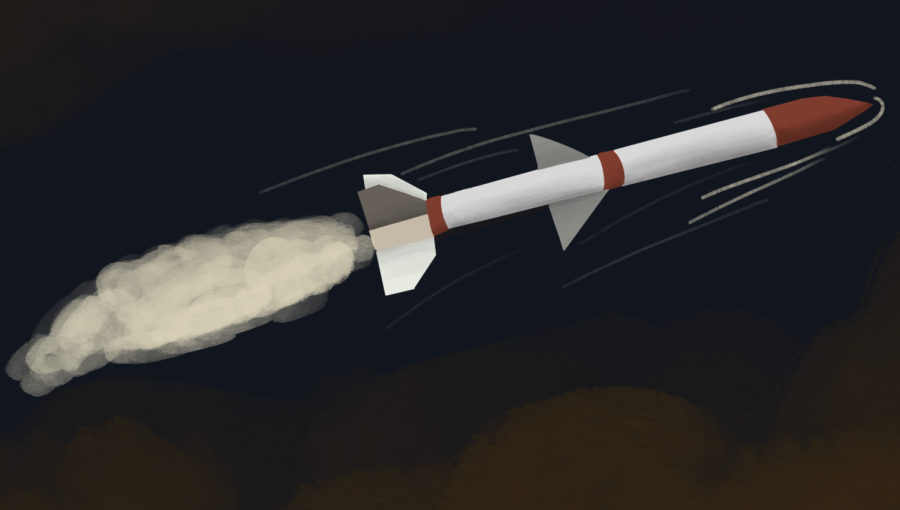Nuclear spring: How global conflicts threaten the environment
Graphic illustration by Meera Nambiar and Anwen Huang
Global conflicts raise the concern of nuclear warfare, which would devastate the climate and lives of countless people.
April 5, 2022
As the Russian invasion of Ukraine escalates, concerns over Russia’s large arsenal of nuclear weapons emerged. A nuclear war would devastate the climate and permanently damage future generations.
“People would be shocked at how massively destructive they are,” AP U.S. History teacher Kyle Howden said. “It’s not something that you would ever want to see deployed because it would be catastrophic for the whole world, even though it might be one location where it’s being used.”
A nuclear weapon is a weapon that explodes due to nuclear fission, nuclear fusion or a combination. Nuclear fission is when a large and unstable nucleus is split into two lighter, more stable nuclei. Nuclear fusion is the opposite: the combination of two nuclei. While fusion reactions produce more energy than fission and do not produce radioactive products, they are more difficult to maintain because they require high pressure and temperatures to occur.
“The science behind nuclear weapons is complex and multi-layered,” UC Berkeley Nuclear Chemistry professor Darleane C. Hoffman said. “There are many triggering aspects which set each other off, much like a domino effect. The reason why the nuclear bombs are highly hazardous is because of the combination of both nuclear fission and fusion. Not only does it vastly damage the environment by blasting out uncontainable amounts of energy particles and radioactive chemicals, but it also has irreversible, lasting effects on the bodies.”
Atomic bombs use nuclear fission and hydrogen bombs use nuclear fusion. Atomic bombs are typically the result of fission reactions between uranium or plutonium. Hydrogen bombs use isotopes of hydrogen. These weapons are highly harmful because they release large amounts of energy and radiation. When dropped, a nuclear weapon releases a shock wave, along with lethal ionizing uranium and enormous amounts of heat, causing mass destruction. Convection currents carry the debris into the air, creating the mushroom cloud often associated with nuclear weapons. When this radioactive debris settles, it destroys the ozone layer, resulting in more direct contact with the sun and causing more droughts.
Nuclear bombs have only been used once: the U.S.’s bombing of Hiroshima and Nagasaki. The catastrophic effects of the two bombs led to Japan’s immediate surrender. The initial detonation in Hiroshima killed an estimated 80,000 people, but the total death toll, which included casualties from radiation exposure, reached approximately 140,000. In Nagasaki, the death toll was estimated to be 70,000. Long term effects continued to be felt in the following decades through increased risk of cancer, which extends to this day.
“During that time, we destroyed so many buildings, and that comes with lack of electricity and gas leaks,” junior and Lynbrook Conservation Action Association member Cindy Chou said. “The mass destruction will definitely have an effect on not just the environment, but also on everyone’s lives.”
In the aftermath of the bombings, Hiroshima and Nagasaki experienced “black rain,” a phenomenon in which radioactive soot and dust fell from the sky. The black rain damaged habitats, contaminating rivers and harming wildlife. It also deteriorated infrastructure and caused radiation poisoning through the inhalation and the consumption of contaminated food and water. Thermal radiation from the explosions burned the surrounding area, but was later suppressed by the natural process of rapid cooling, when energy disperses from the nucleus and is distributed through other parts of the environment. These circumstances allowed for the formation of enough nitric oxides to weaken the concentration of the ozone layer, which is essential to blocking the sun’s carcinogenic UV rays from entering the surface.
“We have to be careful of the future and the way we use our resources,” Chou said. “The radiation is already impacting global warming and hurting the environment. In the future, we could run out of resources at a high rate and kill animals.”
In recent decades, nuclear disarmament has become increasingly appealing as the threat of nuclear warfare increased with the amassing of nuclear weaponry. Ukraine, then in possession of the world’s third largest nuclear arsenal after the collapse of the Soviet Union, signed the Budapest Memorandum with Russia, the U.S. and the U.K. in 1994. The signed agreement promised Ukraine’s security if it denuclearized and returned its estimated 5,000 weapons to Russia. Russia first violated the agreement when it annexed Crimea in 2014 and again during its invasion of Ukraine in 2022, facing little consequences. Today, approximately 13,080 nuclear weapons exist worldwide, and the complete disarmament of nuclear weapons is a goal in process.
“The whole point of a nuclear weapon seems to just be to generate fear,” Chou said. “We already have fewer nuclear weapons than we did — I don’t think we need enough to destroy the world. It’s really scary thinking about how we would all die just because of a bomb being set and someone saying yes. It just makes me realize how easily our lives can just be thrown away.”




































































